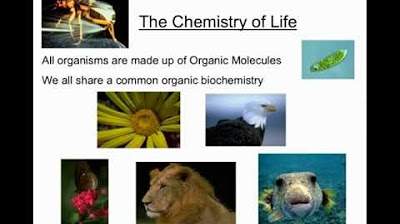The Chemistry of Water Screencast Session 1
Summary
TLDRIn this chemistry lesson, Mr. Gales introduces the unique properties of water, focusing on its molecular structure and the hydrogen bonds that form between water molecules. The session explains how water's polarity, due to the unequal sharing of electrons between oxygen and hydrogen atoms, leads to a slightly negative charge on the oxygen side and a slightly positive charge on the hydrogen side. This polarity is crucial for understanding water's interactions and its role in biology. The video also delves into the concept of hydrogen bonding, which is a weak but significant attraction between the hydrogen of one water molecule and the oxygen of another, contributing to water's remarkable properties essential for life.
Takeaways
- 🌟 Water's unique properties stem from its molecular structure and the hydrogen bonds that form between water molecules.
- 🔬 The chemical formula for water is H2O, consisting of two hydrogen atoms covalently bonded to one oxygen atom.
- ⚛️ Oxygen's higher electronegativity creates a polar covalent bond, resulting in a slightly negative charge near the oxygen and a slightly positive charge near the hydrogens.
- 🧲 The polar nature of water molecules leads to the formation of hydrogen bonds, which are weak attractions between the hydrogen of one molecule and the oxygen of another.
- 🌐 Hydrogen bonds are crucial for the structure and behavior of water, allowing water molecules to cluster together.
- 🌱 The formation of hydrogen bonds is essential for understanding various biological and chemical processes involving water.
- 💧 Water's ability to form hydrogen bonds contributes to its high surface tension, which can cause water droplets to be pulled up on surfaces like leaves or cars.
- 🌡️ Hydrogen bonds influence water's physical properties, such as its high heat capacity and its anomalous expansion when freezing.
- 🌍 Water's polar and hydrogen bonding characteristics make it a universal solvent and a key component of life on Earth.
- 📚 Understanding the structure of water and hydrogen bonding is fundamental for further studies in chemistry, biology, and environmental science.
Q & A
What is the main focus of Mr. Gales' screencast session?
-The main focus of Mr. Gales' screencast session is to explore the unique properties of water that derive from the structure of the water molecule and the hydrogen bonds between these molecules.
What is the chemical formula of water?
-The chemical formula of water is H2O, which consists of two hydrogen atoms bonded to one oxygen atom.
Why are the bonds between hydrogen and oxygen in a water molecule described as polar covalent bonds?
-The bonds between hydrogen and oxygen in a water molecule are described as polar covalent bonds because oxygen has a greater electronegativity value, causing it to pull the electrons closer to itself, leading to an unequal sharing of electrons.
What is the result of the polar covalent bonds in the water molecule?
-The result of the polar covalent bonds in the water molecule is that the oxygen end of the molecule has a slightly negative charge, while the hydrogen end has a slightly positive charge, making the entire molecule polar.
What is the significance of the polar nature of water molecules?
-The polar nature of water molecules is significant because it allows for the formation of hydrogen bonds, which are crucial for many of water's unique properties and its interactions with other substances.
What is a hydrogen bond and why is it important in the context of water?
-A hydrogen bond is a weak attraction between the hydrogen atom of one molecule and a slightly negative atom within another molecule. It is important in water because it allows water molecules to form clusters held together by these weak attractions, which is at the core of water's amazing properties.
How many hydrogen bonds can each water molecule form?
-Each water molecule can form up to three additional hydrogen bonds.
What is the difference between a hydrogen bond and a polar covalent bond?
-A polar covalent bond is a bond within a molecule where electrons are shared unequally, while a hydrogen bond is a weak attraction between the hydrogen atom of one molecule and a slightly negative atom of another molecule, such as oxygen in the case of water.
Why are hydrogen bonds considered weak compared to ionic or covalent bonds?
-Hydrogen bonds are considered weak compared to ionic or covalent bonds because they involve a less strong electrostatic attraction between a slightly positive hydrogen and a slightly negative atom, as opposed to the full sharing or complete transfer of electrons in ionic or covalent bonds.
How does the structure of water molecules and the hydrogen bonds contribute to the properties of water that support life?
-The structure of water molecules and the hydrogen bonds they form contribute to properties such as high heat capacity, high surface tension, and the ability to dissolve many substances, which are all essential for life processes.
What activity does Mr. Gales recommend to further understand the hydrogen bonding in water?
-Mr. Gales recommends using physical models of water molecules to visualize and understand how hydrogen bonds form between them, which can help in grasping the concepts discussed in the screencast.
Outlines

此内容仅限付费用户访问。 请升级后访问。
立即升级Mindmap

此内容仅限付费用户访问。 请升级后访问。
立即升级Keywords

此内容仅限付费用户访问。 请升级后访问。
立即升级Highlights

此内容仅限付费用户访问。 请升级后访问。
立即升级Transcripts

此内容仅限付费用户访问。 请升级后访问。
立即升级浏览更多相关视频

How to Write Chemical Equations

Basic Chemistry Screencast Session 4

From Novice to Expert: Naming Chemicals Made Easy

Concentration and Molarity: The Key to Chemical Solutions

Massa Atom Relatif (Ar) dan Massa Molekul Relatif (Mr) || Kimia Kelas X ||

Lab Equipment - Explained

Organic Biochemistry Screencast Session 1.mp4
5.0 / 5 (0 votes)
